We’ve nearly given up hope and are about to paddle back in, when off in the distance, we spot a fin near where the estuary meets the sea.
“They’re headed this way,” our guide calls out, setting off.
We paddle to join him, hoping to get a closer look at the estuarine dolphins. Yet, every time we get closer, the dolphins change course. Paddling back and forth across the water, we try to predict their movements in the setting sun, until time runs out. From afar, we watch the dolphins disappear up the estuary in the fading light.

I’d driven up the coast to the twin towns of Agnes Water and 1770 (the latter named for Captain Cook’s date of arrival) in Queensland, Australia to get a better perspective on how paddlers can engage with wildlife in the most ethical manner possible. But trying to get closer to the dolphins made the premise seem laughable. What effect—if any—could paddlers possibly have on wildlife, particularly when the animals in question can swim up to 40 kilometers per hour?
Earlier that morning, 1770 Liquid Adventures co-owner Janina Speck had taken me for a morning paddle along the mangrove edges. Originally from Germany, Speck—a diving instructor by trade—decided to settle in Agnes Water due to its proximity to the Great Barrier Reef. Operating a kayaking company was a natural extension of Speck’s love for marine conservation, since it would allow her to engage with a wider audience.
When I ask her about the impact of kayakers on marine wildlife, our conversation instead quickly turns to poor conservation practices of recreational fishermen.
“There’s really no need for rules for kayakers because we move so slowly,” she says.
It was a sentiment I’d heard before—many kayakers, canoeists and standup paddleboarders I spoke with had echoed these thoughts. Kayaks and canoes are eco-friendly, while motorboats and personal watercraft destroy fragile ecosystems. It’s a somewhat absurd dichotomization to make—akin to cyclists versus drivers—but is there any truth in it?
With paddlesports on the rise—kayaking is still one of the fastest growing sports in North America, according to the Outdoor Industry Association—and tour operators worldwide expanding to new regions, the question of our impact on waterways is more pressing than ever. It could be easy enough to say we’re not part of the problem, but research has a very different message. Paddlers, without question, have the potential to alter the behavior and ultimately the well-being of marine animals, however their actions exist in a grey zone when non-endangered species are concerned.
Kayakers have the benefit of moving quietly and not emitting gases or by-products into the water—but animals aren’t living in a vacuum.
“Kayakers have the benefit of moving quietly and not emitting gases or by-products into the water—but animals aren’t living in a vacuum,” says Rick Snowdon, co-owner of Spirit of the West Adventures, a British Columbia-based company specializing in whale watching. “If we’re not mindful of how we behave on the water, we certainly have more of an impact than some of us would believe.”
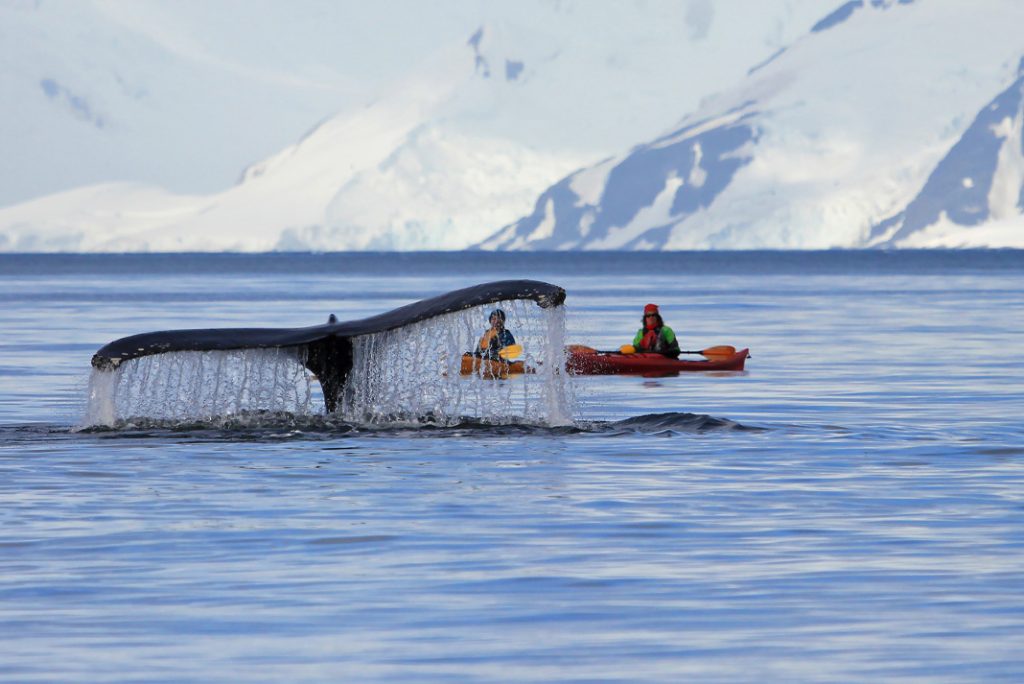
A whale of a problem
One lazy Sunday, I headed to Rapaki, a small Maori settlement on the edge of the Banks Peninsula, just 15 kilometers from the city center of Christchurch, New Zealand. Luck was on my side. New Zealand’s “long white cloud” broke for the first time in weeks, bathing Whakaraupo Harbour in sunshine.
Out on the water, it wasn’t long before I put down my paddle to soak it in. Waves gently lapped at my kayak as it drifted. I didn’t notice I’d floated close to a set of sea caves until it was too late—I was already under attack.
With a shrill squawk, a gull flew up from the shore. Agitated, it swooped down over my head—low enough I had to duck—before circling back and swooping down again and then again.
The scene felt familiar. A couple of months earlier, I’d spoken with Jon Marin, owner of Immelns Kanotcenter, a popular canoe center in Sweden’s Lake District.
“People tell me they had the most amazing meeting with an osprey circling their canoe because it was so interested, and they stayed a long time to enjoy the show,” he told me. “I then tell them the osprey circles not because it is interested or playful, but because it feels threatened.”
Sure, it was a single gull and probably a hypocritical one at that. Gulls aren’t exactly a species known for respecting personal space. And sure, I was just one kayak. But the caves were likely a nesting site, and how many kayakers pass too close to this same shoreline every day?
It’s in this—the cumulative effects on wildlife—paddlers are arguably just as culpable as motorized boat users. It’s easy to rest on one’s laurels and assume moving slowly and quietly isn’t harmful, but research demonstrates the very opposite may be true.
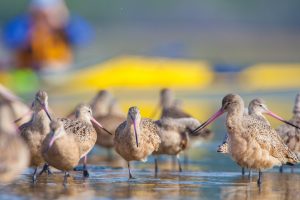
Take the case of California’s Alcatraz Island, which is a nesting site for Western gulls, cormorants, snowy egrets and other waterbirds. Since 1991, Point Blue Conservation Science—a nonprofit wildlife conservation and research organization—has been monitoring the site. What it has found is of all disturbances, including those from land, air and sea—yes, including motorboats—the nesting birds are most disturbed by the approach of kayaks. Put off their nests, birds risk losing their young. It only takes 25 minutes for an egg to cool, particularly on a windy day, and that’s if an opportunistic predator doesn’t eat it first.
It’s not just nesting birds responding negatively to paddlers. According to a 2011 Audubon Society study, non-motorized boats caused waterfowl and diving ducks to flush when only 99 meters away, on average. In one recorded instance, a single kayak resulted in 600 cormorants flushing.
The exact ecological cost of these types of disturbances remains largely undocumented, but there are some safe conclusions biologists can draw. One of the biggest concerns, writes Kathi L. Borgmann, author of the Audubon Society paper, is a loss of foraging time.
“Because flying is energetically expensive, birds flushing in response to disturbance will need to acquire additional resources to compensate,” writes Borgmann. “Thus, disturbance, especially if frequent, could…potentially impact populations.”
It might be hard to imagine people actively paddling up to check out a gull, but the same can’t be said of sea otters. It’s hard to resist trying to get a closer look at these puppies of the sea.
According to biologists at Monterey Bay National Park, continual interactions with paddlers are akin to “death by a thousand cuts.”
When approached, otters typically dive or swim away, costing them valuable energy only recouped by hunting and fishing, rather than resting. The ensuing weight loss can open up to risk of infection and diseases. Chronic disturbances, including those by kayakers, account for 40 percent of all the violations recorded each year in Monterey Bay.
“A lot of the time, it’s out of ignorance,” says Snowdon. “People aren’t willfully going out of their way to harass an animal.”
It’s an ignorance Snowdon believes is only perpetuated by the quest for all-important likes; one that compounds when social media influencers are imitated.
“You see examples of it all the time,” says Snowdon. “Anytime there’s a viral video getting shared of ‘look at this kayaker paddling over top of a killer whale’ it makes me pull my hair out.”
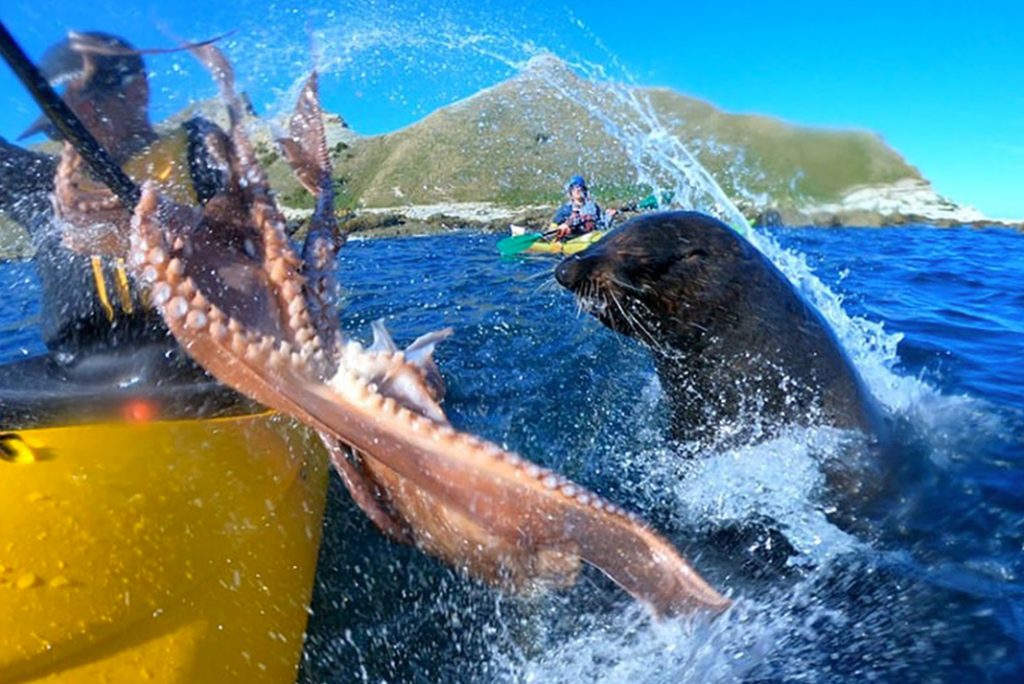
Crossing boundaries
Perhaps no viral video in recent history better captured this tension than the “seal slaps kayaker with octopus” video. It was late in September when Kyle Mulinder, a GoPro ambassador, set out with Kaikoura Kayaks, a tour operator based on New Zealand’s South Island. He was seated in the back of a tandem kayak when—as described in the video’s title—an octopus was flung at his face by a feeding fur seal.
The video was picked up by the Guardian, BBC and the New York Post, and within days, it had hundreds of thousands of views. It was indisputably an incredible interaction, made all the more incredible by the fact it was caught on film. But for guides such as Snowdon, it raised questions. Namely, why had the group been paddling so close to foraging animals, which is generally considered one of the cardinal sins of ethical marine wildlife viewing?
It’s a grey day when I head to Kaikoura Kayak’s outpost, located just off the beach town’s main strip, hoping to answer this question. On the wall, a whiteboard shows the tide times (4:30 p.m.), swell forecast (East, one meter) and recent hazards (“octopus slapped in your face”).
I’m greeted by Conner Stapley, the same guide who took our Mulinder’s group.
“It was my five minutes of fame,” he jokes when I ask about the incident—he had five before that, too, when he discovered geothermal bubbles following an earthquake in the area in 2016. Although Stapley says his motto is, “selfie sticks sink boats,” it hasn’t stopped tourists from requesting to be slapped in the face by an octopus.
Kaikoura Kayaks has also been cashing in on its fame by actively promoting opportunities to get up close to New Zealand fur seals while they forage. In doing so, they’re not actually in violation of any of the three marine wildlife viewing permits they hold.
Mulinder’s group was kayaking so close to the seals that day, I learn, simply because they legally could. Strict regulations exist in New Zealand for how close watercraft can come to the seals on land, but none exist for seals in the water. Stapley says this is because seals are considered to be adept swimmers—if they didn’t want to be near the kayaks, they would just swim away.
According to John Baston, a kayaking guide who spent 10 years working as a park ranger in six American national parks, that’s why the problem isn’t with individuals, but with legislation. Rigid regulations exist for endangered species—with steep fines for infractions—but don’t cover others, such as intertidal animals or common birds. And while tour operators may require permits, there’s little education of independent paddlers.
Similarly, the majority of waters worldwide remain unprotected. This is more to the point for paddlers, since they’re able to access wilderness areas larger watercraft can’t.
For example, at Alaska’s Glacier Bay National Park, where Baston guides with Mountain Travel Sobek, the water is protected. But just beyond, it’s maintained by the State of Alaska.
“They might have some loose regulations about how you’re supposed to treat animals, but there’s no enforcement. You won’t see any boats or rangers,” he says.
Even for those waters closely monitored, there’s still a lack of accountability. In January 2018, the Soundwatch Boater Education Program—an initiative of Washington State’s up-to-date Whale Museum—released the findings of an 18-year-long study on whale interactions in the Salish Sea. The results were alarming; not only had the number of kayakers increased by 30 percent, so too had the number of kayakers coming too close to critically endangered pods of whales. The paper’s authors noted regardless of the mode of transport—motorized or non-motorized—these interactions interrupted the feeding, travel and socialization of orcas.
“What we have seen is kayak incidents increasing because they are a lower priority, from an enforcement standpoint,” Elizabeth Seely, the paper’s lead author on the paper, told the Seattle Times. “Some kayakers are not abiding by laws, paddling out to the killer whales to get closer to them; it is really upsetting to see. And they don’t have any consequences for it.”
This is why it’s so important paddlers do their homework and opt for tour operators who have conscientious standards and can provide guidance on how to interact with each species.
Just last July, Canada strengthened protection for marine mammals, madating a 100-meter approach distance for most whales, dolphines and porpoises, which is inclusive of kayakers. However, this inclusion is uncommon. The reason authorities ignore paddlers may be the same reason paddlers ignore the rules. Some say blanket regulations don’t make sense when kayaks and canoes don’t have the same speed or maneuverability as a high-speed boat. After all, what do you do if a whale approaches you directly?
That’s the argument Peter Grubb, founder of ROW Sea Kayak Adventures, an operator with tours in North America, Latin America and Europe, makes. He insists whales approach paddlers out of curiosity and playfulness, not the other way around.
“Whales don’t have to come over near us in the first place. It defies common sense to say there’s something wrong or unethical about that,” says Grubb. “It creates a more powerful experience. If anything, it creates stronger advocates for the protection of the animals.” ROW is a member of the Responsible Whale Watch Partnership, which aims to raise the standards of whale and dolphin watching worldwide. Their global guidelines recommend motorboats keep a distance of 100 meters from whales and 50 meters from dolphins, however don’t have specific guidelines for kayaks.
I’m not sure how Grubb’s opinion sits with me. Hasn’t history demonstrated any time wild animals get comfortable with humans, it doesn’t bode well for either party?
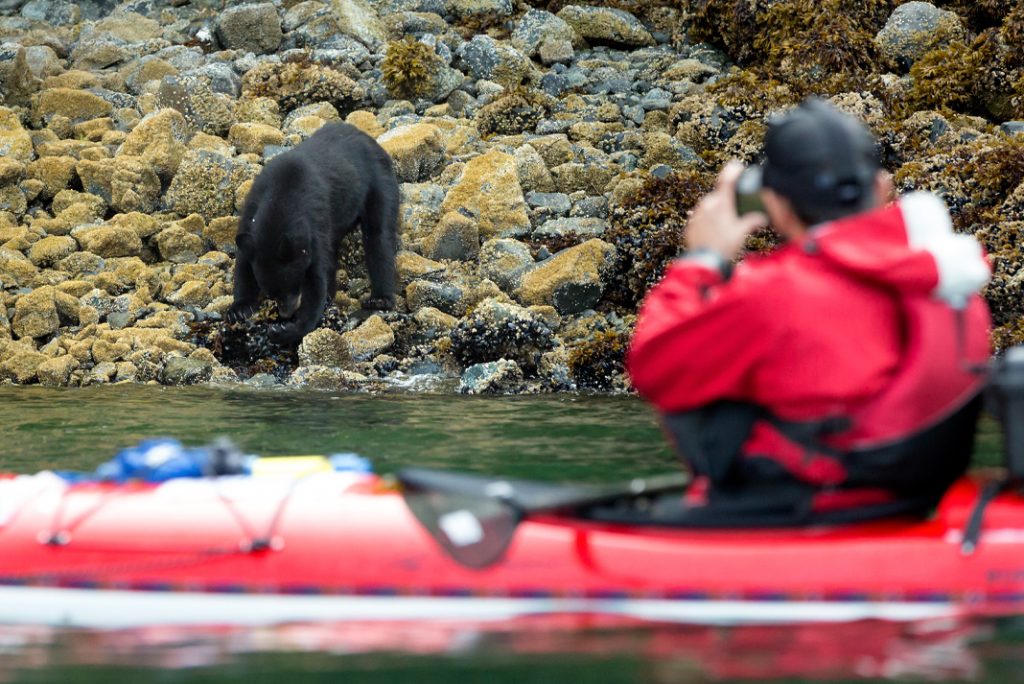
Close encounters
This is weighing on my mind as Stapley and I splash through the surf at Kaikoura. We’re in a tandem sea kayak looking for little penguins, when Stapley spots a small pod of dusky dolphins. They’re swimming through the rolling swell about 150 meters away. We’ll never be able to paddle closer to them in time, I think, remembering my experience in 1770.
Then, the first dolphin’s fin appears next to my paddle, close enough I could touch it. I let out a surprised yelp. It’s joined by others and in no time, we’re surrounded. The dolphins chase each other, flipping playfully on their backs under the water, exposing the white of their bellies.
It’s mesmerizing. Suddenly, I get what Grubb meant. No matter which way we paddle, the dolphins follow, staying with us for more than 20 minutes. We couldn’t stay 30 feet away from them if we tried.
It’s then I remember something Baston told me. At Glacier Bay National Park, the Huna Tlingit people are once again allowed to collect plants and gull eggs within the park.
“Nature writer Barry Lopez said one of the biggest mistakes the Europeans made when they came to North America was they mistook it for a wilderness. People had been living there, changing the landscape and killing populations of animals for a long time,” says Baston. “Things have been altered and manicured by humans for a long time—and I think it’s that way on the sea coast.”
Wherever there is water, people have paddled for thousands of years—and the onus is on us to protect those waterways for another thousand.
Jessica Wynne Lockhart is a freelance journalist who splits her time between Canada, Australia and New Zealand. The contributing editor of Verge Magazine, a publication devoted to travel with purpose, she’s passionate about ethical and responsible adventures.
Eye to eye with a harbor seal, near Protection Island in Washington state. Many photos of paddlers and wildlife we see have been taken with a telephoto lens and cropped. | Photo: Gary Luhm


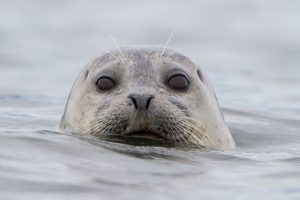
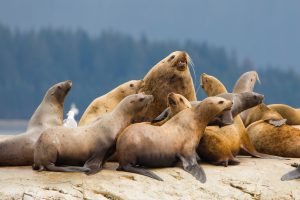
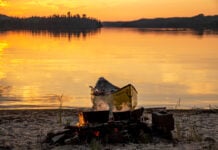
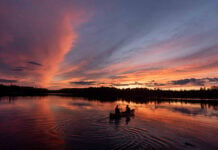
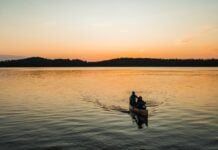
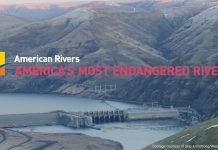
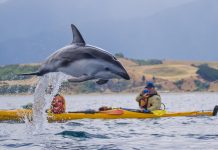

This is an important article, and I know too many fellow paddlers who should read it but probably won’t. The comments about kayaks causing a bigger disturbance than motor boats for some species may be hard for some to believe, but I have experienced this, repeatedly, first hand. I spent a couple of years volunteering for CT Audubon, conducting weekly osprey nest monitoring on Long Island Sound. As a paddler, each year I chose to “adopt” a few nests that were out on the water — atop day markers and light houses — for which Audubon was far less successful in finding volunteers. At first, this felt virtuous. But even while doing my best to keep my distance, as we were advised, I quickly noticed that big, noisy power boats could zip past these channel markers within a few yards with no change in the birds’ behavior. On the other hand, when I approached — even at a much greater distance — the adults would leave their nestlings, circling me and screaming. (You would have to be pretty oblivious to not recognize this as defensive behavior.) Maybe they are just more habituated to the far more common power boats. Or maybe something stealthily sneaking up on their nest seems more like a potential predator. Now, I just keep my distance. These birds have made an extremely successful comeback on the Sound anyway — I don’t think they really need human chaperones, however well-meaning.
Jessica’s trip on Lyttelton Harbour from Rapaki indicates she was probably off Quail Island and gulls always nest on one corner near the caves. If nesting, they will get agitated if you appraoch. Any other time of the year they won’t bother noticing you.
There is one popular kayaking area in New Zealand, Abel Tasman National Park. As kayaks are common on that coast, the seals know they pose no threat. I’ve had two youngsters clambering on to my aft deck while another paddler had one trying to climb on to his fore deck. Those on the land totally ignore you. Another part of the coast, a shag wondering if it should step off the rock and on to my partner’s kayak or not. In other places around the country they will not let you get closer than about 50 metres before flying off.
Our beach on Banks Peninsula usually has a pair of oyster catchers wandering up and down. They aren’t perturbed when you go down to the shore, within 10 metres or closer, give them a wave and wander off and they are either looking for dinner or often are having a snooze and not interested in you.
In Samoa we had a bird hitch a ride on the guide’s kayak from one island to the next.
If people are common and non-threatening, wildlife will learn to ignore them.
In the UK we have a rule that if you are in the sea you must go no closer than 50 metres. They can come to you, as some of the more curious sea mammals will do. Tour boat companies know this but some still go in close to dolphins and whales. We have responsible companies. Many kayakers and individuals do not know the distance rules and will not bother to find. The same for caves and cliffs covered with nesting birds